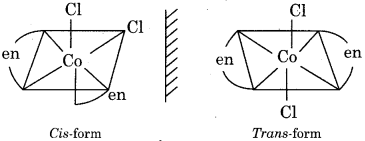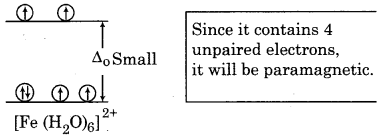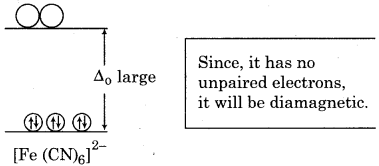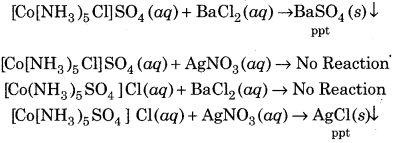Rajasthan Board RBSE Class 12 Chemistry Chapter 9 Coordination Compounds
RBSE Class 12 Chemistry Chapter 9 Text Book Type Questions
RBSE Class 12 Chemistry Chapter 9 Multiple Choice Questions
Question 1.
The oxidation state of Fe in K4 [Fe(CN)6] is
(a) +2
(b) 3
(c) O
(d) None of these
Question 2.
Which of the following compound has tetrahedral shape?
(a) [Ni(CN2)2-
(b) [NiCl4]2-
(c) [PdCl4]2-
(d) [Ni(CN)4]2-
Question 3.
The coordination number of (EDTA)4- is
(a) 3
(b) 6
(c) 4
(d) 5
Question 4.
The number of geometrical isomers of the [Pt(NH3)2Cl2] is
(a) 3
(b) 2
(c) 4
(d) 1
Question 5.
A complex which is formed by chloride and nitrate ligand gives two moles of precipitate of AgCl with AgNO3. Its molecular formula will be
(a) [CO(NH3)5NO3]Cl2
(b) [CO(NH3)5CI]CINO3 CI
(c) (CO(NH3)5Cl]NO2
(d) None of the above
Question 6.
Which of the complex shows optical isomerism ?
(a) [CO(CN)6]3+
(b) [ZnCl4]2-
(c) [CO(CN)2Cl2]
(d) [Cu(NH3)4]2+
Question 7.
The hybridisation of [Ni(CO)4] is
(a) sp
(b) sp2
(c) dsp2
(d) sp3
Question 8.
Chlorophyll contains
(a) cobalt
(b) magnesium
(c) iron
(d) nickel
Answers:
1. (a) 2. (b) 3. (b) 4. (a) 5. (c) 6. (c) 7. (d) 8. (b)
RBSE Class 12 Chemistry Chapter 9 Very Short Answer Type Questions
Question 1.
Calculate the oxidation state and coordination number of central metal atom in the K3 [Fe(C2O4)3]
Answer:
As K+ ion carries charge = +1, charge on 3K ions = +3.
Hence charge on complex ion = +3. As each oxalate ion C2O2-4 has charge = +2, charge on three C2O2-4 = -6. Therefore charge on Fe should be = +3 i.e., oxidation number of Fe in the given complex = +3.
Coordination number of ligand = No. of ligand x Denticity
= 3 x 2 = 6 .
Question 2.
Name of the suitable ligand used to determine hardness of water.
Answer:
[EDTA]4- Ethylene diaminetetraacetate ion
Question 3.
Write the IUPAC name of Li[AIH4].
Answer:
Lithium Tetrahyridoaluminate (III)
Question 4.
Draw the mirror image of [CO(en)2Cl2]+
Answer:
[COCl2(en)2]+ exhibits geometrical isomerism as under

Question 5.
Calculate the magnetic moment of Ni2+ ion.
Answer:
Configuration of d orbitals for Ni2+ is 3d8 so the number of unpaired electrons are two therefore the magnetic moment of Ni2+ given by
µ = \(\sqrt { n(n+2) }\)
= \(\sqrt { 2(2+2) }\)
= √8 = 2√2
= 2 x 1.414 = 2.828 B.M.
Question 6.
Write the IUPAC name of [Mn(CO)12]
Answer:
Dodecyl caorbonyl manganese (0).
Question 7.
With the help of an example explain why ambidentate ligands are named so ?
Answer:
Ligands which can ligate (link) through two or more different donor atoms present in it, are called ambidentate ligands. Example: NO–2 and SCN–, NO–2 can link through N as well as O while SCN– can link through S as well as N atoms.
Question 8.
Classify the following ligands as mono, bidentate etc:
(i) en
(ii) CN
(iii) acac
(iv) dmg
Answer:
Ligand Denticity
en Bidentate ligand.
CN– Monodentate ligand
асас Bidentate ligand
dmg Bidentate ligand
RBSE Class 12 Chemistry Chapter 9 Short Type Answer Questions
Question 1.
What is the chelate effect ? Give an example.
Answer:
When a polydentate ligand simultaneously coordinates to a metal ion through more than one donor sites, a ring like structure is obtained which is known as chelate ring and the ligand is known as chelating ligand. Chelate complexes are more stable than ordinary complexes. The stability of complexes is greatly increased by the chelation. This is known as chelate effect.
eg. [Fe(EDTA)]– is more stable as it has five ring structure than [Cu(en)2]2+, it has two ring structure. Greater the number of rings present in a complex, greater is the stability of complex.

Question 2.
Two complexes having molecular formula CO(NH3)5SO4Br are taken in the two bottles A and B. One complex will give white precipitate with BaCl2 and other light yellow precipitate with AgNO3. Calculate the molecular formula of complexes A and B.
Answer:
[CO(NH3)5sBr]SO4 gives sulphate ions in aqueous solution which reacts with Ba+2 on addition of BaCl2 to give precipitate of BaSO4.
[CO(NH3)5Br]SO4 ⇄ (CO(NH3)5Br]2+ + SO2-4
SO2-4 + BaCl2 → BaSO4 ↓ + 2Cl–
However, it does not react with AgNO3 solution.
![]()
The complex [CO(NH3)5SO4]Br gives bromide ions in aqueous solution which gives yellow ppt with silver nitrate.

However, it does not react with BaCl2 solution.
[Co(NH3)5SO4] Br \(\underrightarrow { Bacl_{ 2 } }\) No reaction So, molecular formula of A complex will be [CO(NH3)5Br] SO4 and molecular formula of B complex will be [Co(NH3)5SO4] Br.
Question 3.
Calculate the oxidation state of central metal • atom in the following complexes :
(i) K2[Fe(C2O4)3]
(ii) [Fe(CN)6]3-
Answer:
(i) 1 x 2 + x – 2 x 3 = 0
2 + x – 6 = 0
x = 6 – 2 = + 4
Oxidation state of central metal atom will be + 4.
(ii) x + ( – 1 x 6) = -3
x= -3+6= 3
Oxidation state of central metal atom will be + 3.
Question 4.
What will be geometry of complexes having hybridisation sp3 and dsp2. Give an example of each.
Answer:
The geometry of complex having hybridisation sp3 will be tetrahedral and geometry for dsp2.
hybridisation will be square planar.
e.g., [NiCl4]2- having tetrahedral geometry and hybridization will be sp3 and [Pt(CN)4]2- having square planar geometry and hybridisation will be dsp on central metal atom.
Question 5.
Explain the importance of coordination compounds in extraction of metals.
Answer:
KCN is used to extract silver from Ag2S in the form of cynide complex and then reducing it with zinc as show by the following equations :
4KCN + Ag2S → 2K[Ag(CN)2] + K2S
2K[Ag(CN)2] + Zn → K2[Zn(CN)4] + 2Ag
RBSE Class 12 Chemistry Chapter 9 Long Answer Type Questions
Question 1.
Explain the hybridisation of the central metal atom in the complex [Ni(CN)4]2- with the help of diagram.
Answer:
[Ni(CN)4]2- – Electronic configuration of
Ni : [Ar]4s23d8 Electronic configuration of Ni2+ : [Ar] 4s0 3d8
Outer electronic configuration of Ni2+ :

Pairing of electrons takes place in the presence of strong field ligand CN–. Thus, one 3d orbital becomes vacant.

As the hybridisation involved is dsp’, we get square · planar complex. As there are no unpaired electrons the complex is diamagnetic.
Question 2.
Compare the complex [Fe(H2O)6]2+ and [Fe(CN)6]4- with the help of crystal field theory.
Answer:
H2Ois a weak field ligand and it will have low value of ∆0. As a result, the electrons can fill lower set of dorbitals as well as upper set as : t42ge2g

On the other hand, CN– is strong field ligand, so that ∆0. will be high. As a result, electron will try to remain only in the lower set and will therefore pair up i.e., t62g.

Question 3.
Explain ionisation isomerism. Write IUPAC name of [CO(NH3)5Cl]SO4 and [CO(NH3)5SO4]Cl. Give reasons to show that these are ionisation isomers.
Answer:
Ionisation isomerism-Ionisation isomerism occurs when same molecular formula gives different ions in the solution. For example, [Pt(NH3)4Cl2]Br2 and [Pt(NH3)4Br2]Cl2 are ionisation isomers.
[CO(NH3)4Cl]SO4 – IUPAC
Name – Pentaammine chloridocobalt (III) sulphate
[CO(NH3)5SO4]Cl – IUPAC
Name – Pentaammine sulphato cobalt (III) chloride
On dissolving in water, the two compounds will give different ions in the solution which can be tested by adding AgNO3 solution and BaCl2 solution. When Cl– ions are the counter ions, a white ppt. will be obtained with the AgNO3 and BaCl2 solution. If SO2-4 ions are the counter ions, a white ppt is obtained. It is shown by the following equations :

Question 4.
Write the IUPAC name of the following complexes :
(a) [Pt(NH3 )2Cl(NO2)]
(b) Na[BH4]
(c) [CO(NH3)5CO3]Cl
(d) Zn2[Fe(CN)6]
Answer:
(a) Diammine chloridonitrito – N – platinum (II)
(b) Sodium tetrahydrido borate (III)
(c) Pentaammine carbonato cobalt (III) chloride
(d) Zinc hexacynoferrate (II)